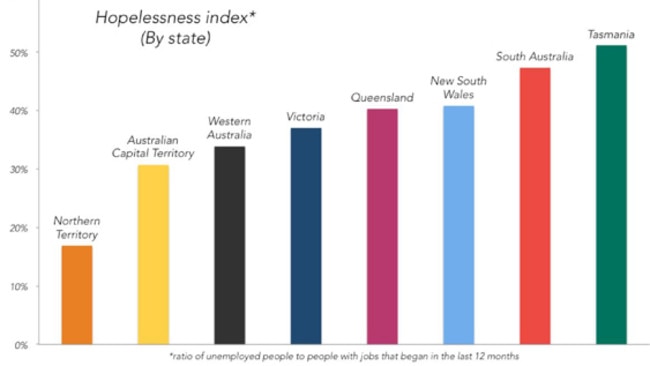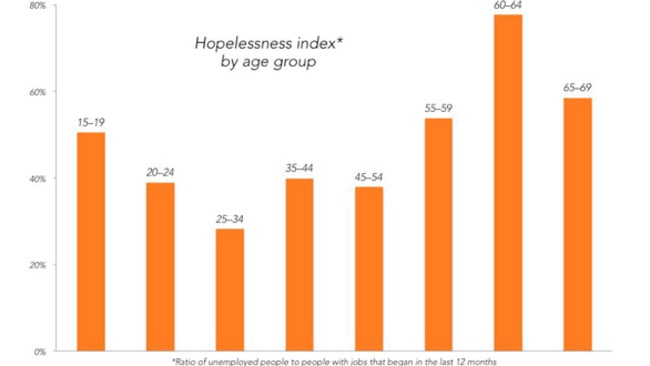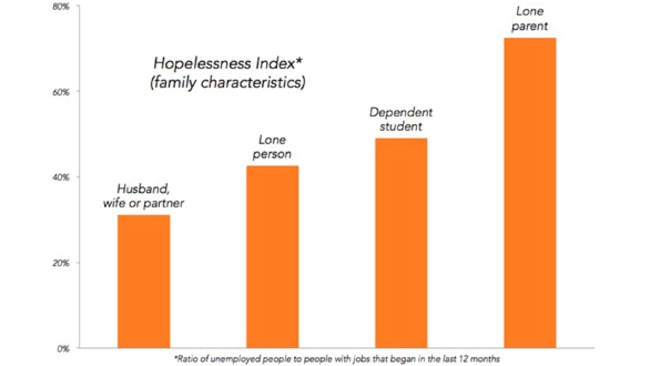Hopeless cases: The bitter taste of Australia’s employment problem
AUSTRALIA’S unemployment rate is at 5.7 per cent, which sounds pretty low. But the true story is a lot worse.

AUSTRALIA’S unemployment rate is at 5.7 per cent, which sounds pretty low. But the true story can be a lot worse.
An analysis of new ABS data on the problem of finding work shows the truth depends a lot on who you are.
Australia has a lot of unemployed people. It also has lots of people starting new jobs. We’ve combined those two numbers to make a “Hopelessness index”.
If there are not many unemployed people and lots of people starting new jobs, hopelessness is low, because even if you lose your job it’s possible you’ll find another one pretty quickly.
Take the Northern Territory for example. The NT counts 5200 people as unemployed, but has 31,000 employed people who started their job in the past 12 months. Those are pretty good odds.

At the other end of the scale is Tasmania. It had nearly four times as many unemployed people as NT — 18,000 — but only slightly more people who started new jobs at 35,000. No wonder many unemployed Tasmanians are fed up and feeling hopeless.
You can do the same analysis by age group. If you’re aged 25-34 and unemployed don’t worry, many people in your age group have just started a new job. There’s lots of reason to hope. If you’re aged 60-64, that, sadly, is no longer the case.

The image of unemployed 62 year olds desperately combing online job listings is heartbreaking. But the awful truth in Australia is retiring is now something of a luxury.
There are 300,000 people out there right now who were involuntarily retrenched and are no longer in work or looking for work. They may have already got their last pay cheque, but they didn’t know it would be their last at the time.
If that is sad, it’s not as sad as this next chart. The numbers for single parents are terrible and the impact on them and their children of low earnings and stress must be utterly awful.

(Being married is a big predictor of labour market success. If you are a married man aged 35-44, your chances of being in the labour force are about 95 per cent and your unemployment rate is below 2.8 per cent. It’s like some sort of labour market utopia. Unmarried men in the same age bracket have 80 per cent participation and 6.4 per cent unemployment. But does marriage lead to work or the other way round? It’s a the-chicken-or-the-egg scenario …)
The extent of hopelessness for lone parents makes me want society to do something to improve their labour market chances.
But this next graph hints the government is not good at helping. It shows the hopelessness index for different ways of looking for jobs. Once you’ve got the government helping you, things are dire indeed.

Remember that this chart doesn’t necessarily show the best strategy for an unemployed person — not all of them can start their own business. Likewise, having an interview is not a strategy so much as a sign things are going well. The fact Centrelink and Job Services agencies are at the bad end is not necessarily because they are bad strategies — it may be they just look after the hardest cases.
But the reality of the numbers is still bleak. We know 345,000 people registered with Centrelink as a job seeker in the year before the survey but only 100,000 people who had registered started jobs. What happens to the rest?
WORKING HARD OR HARDLY WORKING?
And all these charts about hopelessness don’t even consider the underemployed. That is a growth phenomenon and it is hitting women hardest. The following graph shows the number of underemployed part time workers actively looking for more hours, whether in their own job or another job.

The number grew by 40 per cent in the past 4.5 years for women and only slightly less for men.
The extent of underemployment is not to be sneezed at. It’s not just wanting another hour or two. The average amount of extra hours an underemployed person wants is 15 — basically two more whole days on the job.
Australia’s labour market is not in a pretty state overall and when you zoom in on certain groups it gets even more ugly. So don’t believe anybody who tries to airbrush it.
Jason Murphy is an economist. He publishes the blog Thomas The Thinkengine. Follow Jason on Twitter @Jasemurphy




